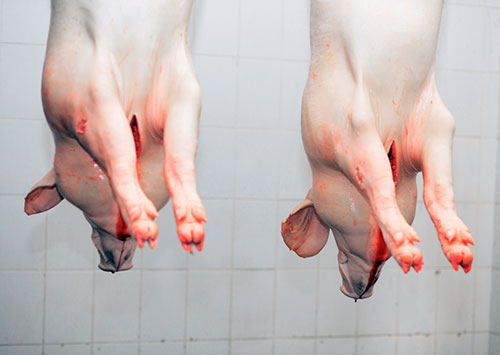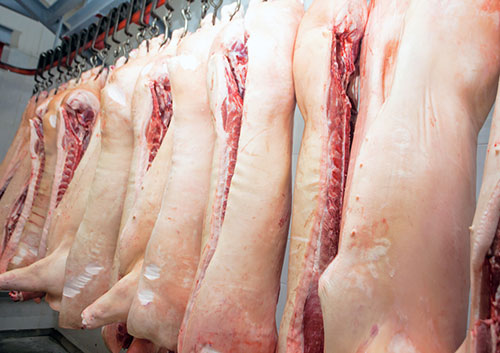



Issues with Carbon Dioxide Stunning of Pigs
CO2 stunning can be reversible; pigs may recover consciousness, therefore the time between stunning and exsanguination is a determining factor for the efficiency of the stunning process.
D. Bolaños-López and colleagues at the Metropolitan Autonomous University and the National Autonomous University of Mexico, presented two poster sessions on CO2 stunning during the 24th International Pig Veterinary Society Congress in Dublin, Ireland in 2016.
Animal Welfare in Pigs That Recovered Consciousness After CO2 Stunning
During the slaughtering procedure, every animal should be unconscious chiefly to avoid inflicting undue pain during bleeding. Exsanguination without prior stunning is an extremely controversial practice from the standpoint of animal welfare because some animals take a long time to lose brain function.
CO2 stunning can be reversible or irreversible; pigs may recover consciousness before dying, so that the time between stunning and exsanguination is a determining factor for the efficiency of the stunning process.
Some researchers have found that pigs should be exposed rapidly to 90% CO2; though it has been shown that exposure to CO2 at 90% for 120 seconds is more effective than exposure for 90 seconds in abolishing consciousness reflexes.
The objective of the present study was to evaluate the effect of different concentrations of CO2 on the stunning of pigs by measuring physiometabolic blood profiles.
A total of 1336 pigs were stunned in a CO2 chamber for approximately 90 seconds. The pigs were classified into four groups: the first group rested in pens and was sampled 3 hours before slaughtering (reference values, RV). The rest of the pigs were assigned to 3 groups, according to the CO2 concentration used for stunning: 85, 90 or 95%.
Each group was then further divided into 2 sub-groups:
A) Pigs exsanguinated during the first 60 seconds after leaving the chamber without recovering consciousness (WRC), and
B) pigs that were exsanguinated after more than 60 seconds and did recover consciousness (RC).
Blood pH of the RC pigs was below 7.08, while blood Ca2+ (>1.59 mmol/L), glucose (>159.79 mg/dL) and lactate (>103.52 mg/dL) levels all increased compared to the control group (P<0.05).
All pigs exposed to CO2, regardless of concentration, presented changes in critical blood variables, and exposure to the gas also affected their acid-base balance, producing a process of acidosis, hyperglycemia, hyperlactatemia, hypercapnia and hyperpotasemia.
This physiological disequilibrium was greater when the animals recovered consciousness seconds after leaving the stunning chamber.
Therefore, it is necessary to reduce waiting times between removal of the pigs from the stunning chamber and performing exsanguination. Under no circumstances should this interval exceed 60 seconds, otherwise the pigs may recover sensitivity.
The study recommends maintaining strict control of entry into, and removal from, the CO2 chamber, in order to avoid backlogs in the slaughtering area and ensure that the pigs do not regain consciousness.

Animal Welfare and Behavioral Changes in Pigs During CO2 Stunning Procedure
In a second study by the same authors, it was noted that early CO2 stunning of pigs is associated with a process of aversion and stress, characterized by different induced behavioral changes.
The effects of CO2 act in two ways: first, causing irritation of the membranes of the nasal mucosa; and second, as an agent that strongly stimulates the respiratory center, causing hyperventilation and suffocation before losing consciousness.
However, signs of aversion such as 'retreat attempts' or 'escape' have been reported in pigs just before completing the state of anesthesia. Keeping a record of behavioral changes during stunning has been a useful tool for determining the absence of welfare in pigs.
The observation and quantification of these behavioral changes and design ethograms during stunning, give guidelines to understanding the process of pig aversion and stress when exposed to CO2.
These observations indicate that just before the pig lose consciousness, there is a transition phase, during which a number of behavioral changes can be observed, such as: 'breathing efforts' with the open mouth, 'ataxia' and 'attempts to incorporate'.
The objective of the present study was to evaluate the effect of CO2 stunning exposure time on pigs by measuring several behavioral changes.
A total 336 pigs were videotaped during the first 30 seconds of the stunning process (at 86% CO2) and then classified in groups according to the time they were exposed to the gas, as follows: T1= 0 to 10 seconds, T2= 11 to 20 seconds, and T3= 21 to 30 seconds.
Sixteen different behavioral traits were recorded and analyzed according to frequency percentage, prevalence, and duration (seconds).
In T1, the most frequent and prevalent behaviors were sitting and standing (assimilation phase); in T2, pigs attempting to escape and stand up showed higher frequency and prevalence percentages (excitation phase); while in T3, the most common behavioral indicators were difficulty in maintaining posture and muscular contractions (anesthetic phase).
'Attempts to escape' and 'loss of posture', have been the most reported behavioral indicators around the world. These denote a clear lack of welfare during stunning.
CO2 stunning method is not conducive to pig welfare in slaughter plants, due to the different behavioral changes that pigs recorded, which are regarded as behaviors of aversion. However, the CO2 concentration used in this study was effective to stun pigs, but caused physical stress and may devalue the last minutes of life of the pigs before exsanguination.
(Photos: Shutterstock)









